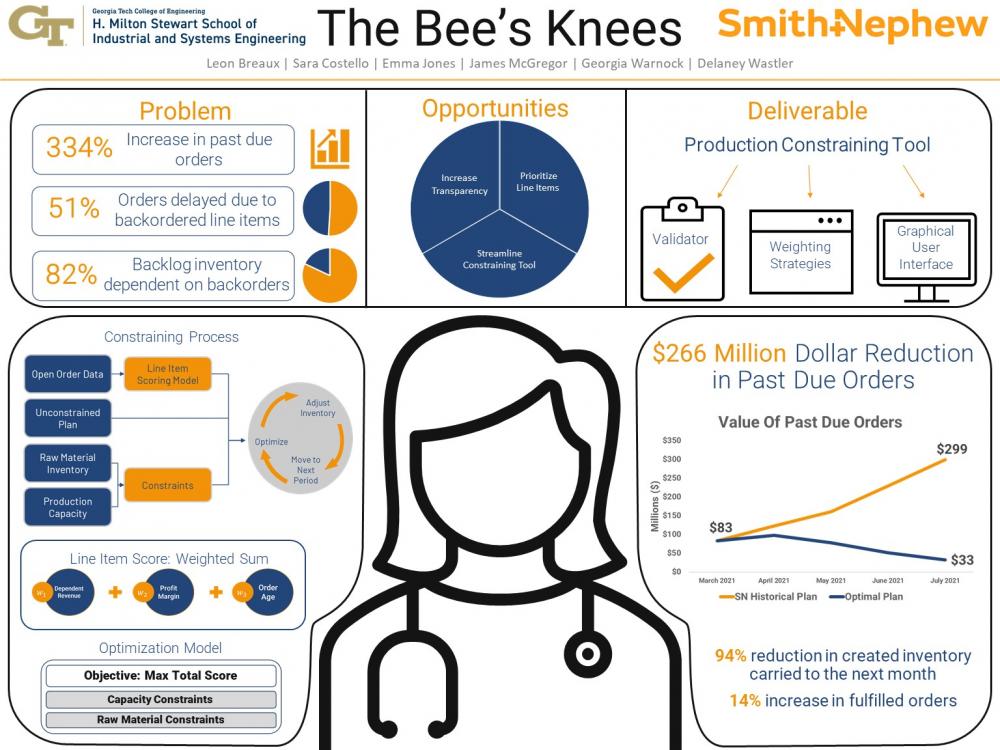Client Context
Smith + Nephew (S+N) is a global medical technology company that designs, manufactures, and distributes medical devices to hospitals and clinics. Smith + Nephew has ten manufacturing facilities and four global distribution centers. Company leadership has noticed that an excessive and growing number of orders are classified as past due. There are a small number of products that are holding up the shipment of entire orders due to not being produced on time. This is causing a decrease in order throughput with an increase in inventory. Smith + Nephew’s system has a significant disconnect between supply from the manufacturing facilities and customer demand.
This project focuses on the Memphis, Tennessee manufacturing planning process. The current process consists of planners constraining production plans using 100+ Excel files. This is a labor-intensive and time-consuming process. Despite the extensive constraining process, the necessary items to fill orders are not being manufactured.
By streamlining the company’s production planning into a single tool, planners will not have to complete the process manually. The deliverable allows planners more flexibility to adjust plans and substantially cut down on total labor spent on constraining. Redesigning this process will also allow for the incorporation of SKU priorities.
Project Objective
Over the past year, Smith + Nephew has seen a 334% increase in past due orders. If this continues to increase, Smith + Nephew will face a decrease in profit due to contracts not being fulfilled on time and a potential loss of customers due to dissatisfaction. This current trend is not sustainable, and Smith + Nephew must reduce the number of past due orders to stay competitive and profitable.
In S+N’s current system, there is not a structured way of determining which SKUs should take precedence when demand exceeds capacity. Analysis revealed that $3.5 million worth of past due orders could be fulfilled by producing only five backordered SKUs, amounting to $1.5 million. The SKUs for these orders should be prioritized because they will directly lead to the fulfillment of orders and reduction of backlogged line items sitting in inventory.
The objective of this project is to reduce past due orders in the system by ensuring that critical products and quantities are available as inventory. Currently, there is a lack of available inventory needed to complete and ship out orders. Orders cannot be shipped until all SKUs in the order are available, which leads to a buildup of inventory. The root cause of the growing number of past due orders is in Smith + Nephew’s production planning process, which does not prioritize the SKUs that will most efficiently fill orders. With no current means of prioritizing SKUs, past due orders are growing in the system at an alarming rate.
To tackle the rising number of past due orders, our team proposes a production constraining tool with a built-in SKU prioritization model. This tool will use order, material, and production data along with unconstrained plans as inputs. The output will output a constrained plan that indicates the number of SKUs to produce in 24 periods at a given work center, as well as illustrating the priority of different SKUs.
Design Strategy
The design involves a Production Constraining Tool that allocates Smith + Nephew’s existing resources to produce high priority SKUs when production is limited. This tool uses an unconstrained production plan, which is the total demand from customer orders, as an input and outputs a feasible constrained production plan, considering persistent constraints within the Memphis production facility such as production capacity, work schedules, and inventory of raw materials. It also grants users the flexibility to input additional constraints to account for unexpected material or labor shortages that impact production capacity and toggle the inclusion of current inventory in the plan.
To create the production constraining tool, three main components were developed: a line item prioritization scoring model, an optimization model which automates constraining, and a user interface to interact with the constraining implementation.
To create the prioritization model, key factors were established. These factors determine the urgency of producing a certain SKU and include order age, profit margin, and dependent revenue. These factors were weighted and summed to give a score for each SKU. The constraining tool utilizes an optimization model to maximize the summed scores of SKUs being produced in each month.
The tool is validated by computing the impact on past due orders, order fulfillment, and inventory over four historical periods, assuming S+ N perfectly executed their production plans in this time. The historical plan is compared with the tool’s output for the same periods.
Deliverables
Production Constraining Tool: The final deliverable is the production constraining tool which is accessed through a user interface. This tool allows for S+N planners to easily modify constraints within the constraining process along with quickly creating the final constrained plan.
Weighting Strategies & Validation: Additionally, the client was provided with an analysis of the possible weighting strategies for line item scoring and their advantages. They also have the script used to validate the outputs of the constraining tool in order to adjust the weights as needed. This allows the client to see how different weights affect the final outcomes of their constrained plan, along with being able to run the validation for future weighting strategies.


